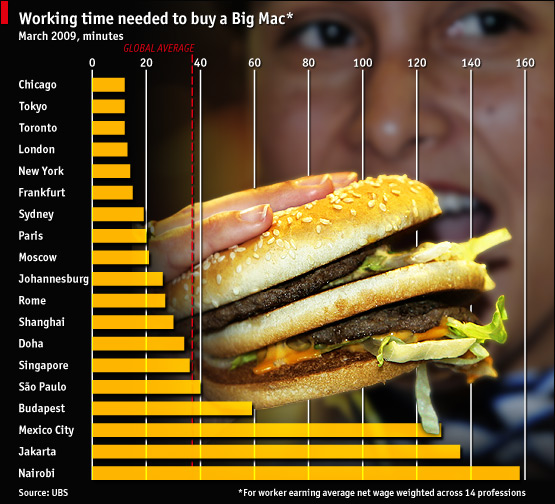
We are always trying to measure things and make comparisons. Our measurements should be accurate but more important is that they are useful. Sometimes we study things for the fun of it, but that is a luxury. For practical professional business we should not bother to do research unless we can and are willing to use the resulting information to change our behaviors.
It is often true that large organizations do research that they don’t use. Sometimes it is because what it measures is just too big or impossible to influence. We often prefer to be involved with the big things rather than those we can really do something about. Beyond that, something consultants would prefer not become generally accepted is that Some of the most useful research is really simple and often free.
The Economist publishes a “Big Mac Index”. The idea is that Big Macs are sold similar all over the world and available pretty much worldwide. It is not scientific but it is useful. You can guess about how much it will cost you to visit the city and how much local currencies are overvalued or undervalued in relation to the U.S.
Now they have a variation. Instead of the cost, it shows how many minutes an average worker has to work to afford the big Mac in his city. It turns some of the relationships around. America is the cheapest in terms of time spent to earn the Big Mac because Americans are well paid in relation to what they buy. It takes an average American just over ten minutes to earn enough to buy a Big Mac. Interestingly, Tokyo is second cheapest. Everybody knows that things are really expensive in Japan, but the Japanese make a lot of money and Big Macs are relatively cheap.
Take a look at the article. You get a different idea when you just look at how much the Big Mac costs. See the article about that here.
The whole idea of the Big Mac Index is based on purchasing power parity. For those unfamiliar with the concept, it measures how much you can actually buy with a particular currency. Supposedly, you should be able to buy the same things in each currency with the equivalent amount in another. If 1 Euro = 1.40 dollars, in theory you should be able to buy $1.40 worth of stuff for one Euro. In fact you cannot, which indicates that the Euro is overvalued compared to the dollar. That is why it is expensive to travel in Europe and it explains why the Brits can usually save money (when you consider hotels, food etc) flying to Disney World in Orlando instead of crossing the much shorter distance to go to Euro Disney.
We created a “Banana Index” in Iraq, inspired by the Big Mac Index. It was meant as a measure of security and progress rather than currency values, but it also had the virtues of being simple, inexpensive and useful. I wrote a post about that and other forms of measurement we used.
